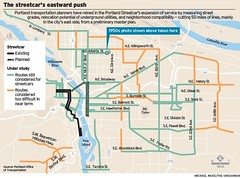Portland Streetcar, map of proposed expansions
Portland is going through an ambitious planning process for streetcar expansion. They started with plans for as much as 200 miles of tracks, and are now down to 75 miles in the latest iteration.
See "Portland mapping its streetcar dreams" from the Portland Oregonian, "Streetcar planning stays on a roll," from the Portland Tribune (the article includes a gaggle of negative reader comments, so Portland isn't as pro-transit as made out to be--and yes, far more people use transit in DC), and the Streetcar expansion project webpage from the Portland Department of Transportation.
(Note to Dan...) From the Oregonian:
While Portlanders have an eight-mile downtown-area streetcar line to view firsthand, the existing service and high-rise development nearby it are not necessarily what they should expect from a new line, Sweeney says.
The eastside routes would almost certainly have less development density than the Pearl, he says. As established neighborhoods, they also would not likely undergo the dramatic industrial wasteland-to-condo transformation the Pearl and South Waterfront had. Smaller-scale neighborhood services and mid-rise development are more likely, he says.
The Portland Streetcar mainly works now as a "circulator" for short trips, says Mark Dorn, an engineer with URS Corp., which is helping with the system plan. For example, downtown office workers can leave their car at work and ride the streetcar to a restaurant for lunch.
But a streetcar along Northeast Sandy Boulevard or Southeast Hawthorne, for example, might serve commuters, Dorn says. Under that strategy, a streetcar would stop just a few times between 39th Avenue and downtown, providing an express route to downtown jobs. Give the streetcar its own lane, and it could zip up to 45 mph.
In this scenario, some streetcar lines could be in the Portland primary transit network, but most in the Portland secondary transit network, if Portland uses a similar typology to the one that I've laid out.
Labels: transportation planning




1 Comments:
Thanks so much for the site, I found a lot of useful information for us.
Post a Comment
<< Home